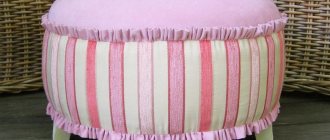Shoe storage
The issue of storing shoes is relevant for many people.
Shoes are an element of clothing, a product for protecting feet from external influences.
Source Wikipedia
Proper shoe storage will help solve many different problems:
- Increase wear time;
- Save free space in the apartment;
- It will help you find the right pair of shoes faster.
The issue of shoe storage is especially acute for large families and owners of small apartments.
The appearance of the shoes, their quality and the period of wear depend on the storage conditions.
Its quality is influenced by many factors:
- Temperature conditions;
- Humidity;
- Dusty.
How to store shoes compactly
How to store shoes if there is little space in the apartment?
An ideal option would be to arrange a dressing room for storing shoes. For a dressing room, an area of 1:1.5 will be sufficient. You can make it in place of the pantry, where you just need to install shelves, racks, cabinets, and bedside tables.
But not everyone has this opportunity. Then you will have to look for other options. In the warm season, you can use a glazed loggia to store shoes. Or think about how to use walls in the hallway more rationally. To do this, you can equip a niche.
Storage methods
Options for storing seasonal shoes depend on the location chosen. On mezzanines, under the bed or on open shelving, boxes, drawers with lids, and plastic organizers are used. The contents of closed cabinets collect less dust; fabric bags are suitable for packaging.
Boxes
The traditional and convenient way is to store shoes in boxes made of cardboard or transparent plastic. The rigid construction protects the boots from deformation, and ventilation holes provide air exchange. The boxes are stacked on top of each other and placed in any suitable place.
If you decide to purchase boxes of the same sample, then select them to match the size of men's or women's shoes. Long boxes are provided for high boots. To make it easier to find the right pair, the opaque packaging can be signed or provided with a photograph. Moreover, it is better to use the box all year round, in the summer for boots, and in the winter for sandals and shoes.
Shoe racks
For temporary storage of shoes in the hallway, use racks with inclined shelves. Their main advantage is their compactness (maximum depth 25 cm). The high rack can accommodate up to 30 pairs of summer shoes. This is a rational option for how best to store shoes if there is little space.
Typically, racks are made of metal or wood, less often of plastic. The niches are mesh or assembled from slats, which ensures air circulation. Prefabricated racks, where shelves can be installed at your discretion at different heights. The only downside is that there is no protection against house dust.
Shoe boxes
Storage boxes vary in capacity. They can be divided into stand-alone and those that are built into the wardrobe design. Drawers are part of a shoe storage system. They place shoes, boots, short boots. The contents are clearly visible and easy to reach.
Self-contained organizers with multiple compartments are lightweight structures that look like a suitcase. The rigid frame is covered with durable fabric and equipped with a carrying handle. This box has from 3 to 12 compartments, the top lid is fastened with a zipper. Small cases are convenient for storing shoes in the dressing room. They can be placed on a shelf or hung vertically by the handle.
Fabric pockets
Textile pockets are used when there is not enough space. Essentially, this is a solution to the problem of how to store shoes and accessories without boxes. Modules with fabric compartments can be hung on the wall of any room: hallway, corridor, dressing room, children's room. Fabric pockets are also used to store shoes in the closet. The textile strip is attached to the door, side wall or hung from a bracket using coat hangers.
The method is suitable for storing slippers, sandals, soft shoes, with the exception of any molded shoes. Fabric pockets are convenient due to their mobility, low cost, and easy care. If necessary, they can be easily removed; when folded, they take up very little space.
Shoe maker
Cabinets whose main purpose is to store shoes are called shoe racks. Outwardly, they look like ordinary cabinets. There are open and closed shoe racks, as well as shoe storage systems that rotate around an axis. More complex designs are equipped with drawers and a soft seat.
The model range is very wide. Small shoe racks are suitable for a small hallway, as they do not take up much space. Larger models that can accommodate almost all seasonal shoes are intended for the dressing room.
How to properly store shoes at home
Before putting your shoes away for storage, you must:
- Choose a location. It should be dark, dry and ventilated. Exposure to sunlight can cause shoes to fade. High humidity leads to mold growth;
- Clean it from dirt and dry it;
- Sort it by season - summer, autumn and winter. Divide into men's, women's, children's;
- Defective shoes need to be repaired, and if they cannot be repaired, they must be thrown away. This way you will get rid of unnecessary shoes and free up space at home;
- To avoid deformation, it is better to push paper inside;
- To prevent drying out, shoes must be treated with softening cream and other special products.
How to prepare shoes for long-term storage
The construction of a shoe rack is always preceded by the preparation of shoes, which consists of several stages:
- Sorting. Review all available pairs. If shoes, boots or sneakers have lost their presentation, part with them. The same should be done with shoes that cannot be repaired. Pairs sorted by size are easier to store. Therefore, put boots, low shoes and Ugg boots to one side, and sneakers, creepers, sneakers to the other.
- The washing up. Clean the sole from dirt and the top from dust. Replace insoles if necessary. If you do not want fungus to colonize your shoes and boots, treat the inside with an antiseptic.
Properly prepared shoes can be stored in closed cabinets for years. At the same time, it does not acquire an unpleasant odor.
Shoe storage ideas
You need to find a place to store shoes so that you can easily find the right pair. There are different solutions invented by designers.
It can be:
Closet
Its lower part is divided into narrow shelves, which are well suited for storing shoes used in everyday life. There are cabinets where the shelves are divided into compartments for high boots and low shoes. This distinction allows you to maintain order in your closet.
If the distance between the shelves allows you to place shoes in 2 rows, you can buy special stands. They are made of plastic and look like small benches. You can put, for example, shoes down and boots on top. At the same time, all the shoes are visible, there is no need to look for what you need now.
Organizers
Some of them resemble a dish drainer. These are convenient for storing slippers. Some allow pairs of shoes.
Many of them are made of fabric and fasten with a zipper.
Models can be floor-mounted or wall-mounted. For a small apartment, a hanging door organizer with spacious pockets is well suited. It can be placed on the door in the hallway or in the dressing room.
Hanging pockets
This is a great option for storing low-heeled shoes, ballet flats, and slippers. They need to be attached to the inside of the cabinet door, which is located in the hallway. To make them, you will need a transparent film so that the shoes are visible through it.
Pockets can be decorated at your discretion to decorate the interior.
Built-in furniture with shelves for shoes
If the hallway space allows, you can purchase built-in furniture with special shelves for shoes that will open 180º.
Shoe hangers
This is a simple design, consisting of a hook with two clamps at the base, capable of holding even a pair of boots. It is hung from a bar, just like a coat hanger.
This option is good for small hallways. You can hang a large number of shoes in one row.
Wardrobe
If there are no problems with space, you can equip a dressing room. To do this you need to buy some components. These can be ordinary slats that allow you to fasten shoes to the heels, and they will be visible.
You can purchase a metal grill, attach it to the wall and hang your shoes by the heels. Or clear plastic containers that can be placed on the floor or on shelves. You can see through the walls what’s inside, so there won’t be any problems finding the right pair. In addition, shoes in such containers will not gather dust or become wrinkled, which means they will retain their original appearance longer.
Specialized stores sell carob shelves, which consist of a strip and U-shaped hooks. Their shoes are easy to put on and take off.
Shoe shelves
Shoe shelves provide an opportunity to neatly store shoes. Their main advantage is that they can accommodate a large number of shoes.
There are many shelf models:
- Single-tier;
- Multi-tiered;
- Mounted;
- Floor-standing.
Retractable and folding shelves are convenient. They protect shoes from dust and sunlight.
Boxes and boxes
Transparent boxes are suitable for sorting shoes for each family member and storing them by season. They provide an opportunity to quickly find the right pair of shoes. They can be placed in a closet or on open shelves.
Plastic boxes are convenient. They are thick enough and do not deform under the weight of the shoes. Basically, they are all equipped with holes for ventilation.
You can also store shoes in wooden boxes. They can be painted in the desired color, varnished and fixed on the wall in the order that suits you.
Boxes and boxes are compact and can be placed on mezzanines.
Shoe racks
As a rule, the stable frame of the rack is equipped with special blades for fixing shoes. Most of these racks involve vertical placement of shoes.
Some models have a lattice surface, there are open and closed racks. They are made in the form of a tall and narrow structure from floor to ceiling.
Shelving
They are usually installed in a spacious hallway, dressing room, pantry or niche. They allow you to neatly line up your shoes. This option is well suited for storing children's shoes, since all of them are at hand and there is an excellent overview of them.
Ottomans
Multifunctional designs in the form of banquettes and sofas fit well into the design of hallways and corridors. Many of them are equipped with shoe storage systems inside in the form of containers or textile covers with many cells.
Wicker baskets
Wicker items are suitable for storing shoes. Eco-friendly wicker baskets can be used to store shoes. You can arrange them on shelves or place them under benches.
How to store winter shoes
Shoes can be stored in hanging bags that do not take up much space on the walls.
In the summer, you have to hide bulky ankle boots, boots and over-the-knee boots to make room for bright flip-flops and high heels. Storing winter shoes does not require using the perimeter of the entire room; it is enough to apply the following tips:
- take an ordinary clothesline, stretch it in a closet or dressing room and secure a pair with a clothespin (up to 7 pairs can fit on 1 m);
- knowing how to properly store winter shoes in a dressing room or closet, you can avoid damage and creases in the material, so it is important to maintain its shape by placing a pair on a shelf or rack at an angle;
- fold each pair into a textile bag, first filling the boots with crumpled paper, hang them in any room or fold them on mezzanines; Just don’t send your shoes to the balcony or garage (high humidity will easily ruin any material).











